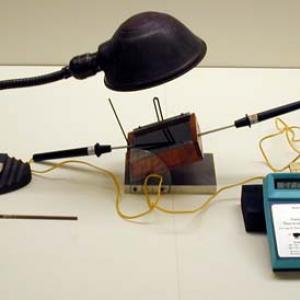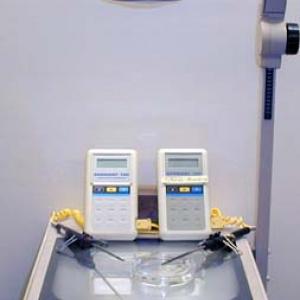College of Liberal Arts & Sciences
4B50.60 - The Greenhouse Effect
See also 4B50.60/8A70.40 in Astronomy and 8A70.40 in Astronomy.
Place the greenhouse onto the table and insert one thermometer into the hole in the top of the unit so that the probe is about in the middle (about 2 to 3 inches). Lay the other probe on top of the unit also about in the center of the glass. Place the light over the unit and adjust the units angle so that it is about parallel with the light and about 8 to 10 inches distant. Put the camera on the digital readout of the thermometers and project this onto the monitors. To demonstrate, turn on the light. The temperatures should be about the same until 90 to 100 degrees Fahrenheit. At this time the greenhouse should rise 10 to 30 degrees above the surface temperature depending on length of time the light is left on. These temperatures will vary depending on the height of the light above the greenhouse. A trial run should be done an hour before the actual demonstration to assure proper operation. Do not rub the carbon off the inner plate as this is the heart of the demo.
Place a thermometer with a blackened probe tip directly on an overhead projector. Turn on the projector and observe the temperature of the probe after three minutes. The temperature should be in the range of 97 to 100 degrees F. Now put the petri dish filled with water between the probe and the overhead projector. Within two to three minutes the temperature should have fallen to 91 to 93 degrees F. (water is absorbing a majority of the infrared radiation).
- Danny Doucette, "The Greenhouse Effect and Anthropogenic Climate Change in the Lab", TPT, Vol. 61, #8, Nov. 2023, p. 660.
- P. -M. Binder, Kelsey D. Foreman-Bunting, Zoe A. Whitney, Allison M. Leach, Elizabeth S. Dukes, James N. Galloway, "Greenhouse Gas Footprints for Physicists", TPT, Vol. 58, #4, April 2020, p. 238.
- Philip G. Sieg, William Berner, Peter K. Harnish, and Philip C. Nelson, "A Demonstration of the Infrared Activity of Carbon Dioxide", TPT, Vol. 57, #4, Apr. 2019, p. 246.
- Thomas C. Gibbons, "Backyard Infrared Trapping", TPT, Vol. 52, #9, Dec. 2014, p. 538.
- Robert Reiland, "Variations on Greenhouse Gas Experiment", TPT, Vol. 45, #8, Nov. 2007, p. 468.
- C. F. Keating, "A Simple Experiment to Demonstrate the Effects of Greenhouse Gases", TPT, Vol. 45, #6, Sept. 2007, p. 376.
- Se-yuen Mak, "The Greenhouse-Effect Experiment", TPT, Vol. 35, #8, Nov. 1997, p. 504.
- Gordon J. Aubrecht, II, "Erratum", TPT, Vol. 26, #5, May 1988, p. 265.
- Gordon J. Aubrecht, II, "Trace Gases, CO2, Climate, and the Greenhouse Effect", TPT, Vol. 26, #3, Mar. 1988, p. 145.
- Robert Neff, Matt Young, "The Greenhouse Effect", TPT, Vol. 21, #3, Mar. 1983, p. 194.
- M. Young, "The Author's Reply", TPT, Vol. 14, #7, Oct. 1976, p. 390.
- E. Scott Barr, "A Common Mistake", TPT, Vol. 14, #7, Oct. 1976, p. 390.
- Victoria Filas and Ludwik, "Greenhouse Box", TPT, Vol. 14, #3, Mar. 1976, p. 169.
- Philip C. Nelson, "Effects of Greenhouse Gases on Earth, Venus, and Mars: Beyond the One-Blanket Model", AJP, Vol. 91, #9, Sept. 2023, p. 721.
- Gerard T. Blanchard, Bryce A. Bowlsbey, James R. Dyess, Ryan D. Rumsey, Justin B. Woodring, "Improved Spectral Photometer for Undergraduate Observations of Atmospheric Infrared Heat Flux and Greenhouse Gas Absorption Bands", AJP, Vol. 91, #8, Sept. 2023, p. 708.
- Paul Wagoner, Chunhua Liu, R. G. Tobin, "Climate Change in a Shoebox: Right Result, Wrong Physics", AJP, Vol. 78, #5, May 2010, p. 536.
- R. M. Fuller, "A Simple Radiometer Using Diodes As Thermal Detectors*", AJP, Vol. 41, #3, March 1973, p. 443.
- Johanna L. Miller, "Passive Radiative Cooling: Not Such an Off-The-Wall Idea", Physics Today, Vol. 78, #2, Feb. 2025, p. 15.
- David M. Barnett, "Effect of Seasons On Greenhouse Warming", Physics Today, Vol. 71, #4, Apr. 2018, p. 12.
- Charles Day, "Methane Emission From Abandoned Wells", Physics Today, Vol. 68, #2, Feb. 2015, p. 17.
- Kerry Emanuel, "Hurricanes: Tempests in a Greenhouse", Physics Today, Vol. 59, #8, Aug. 2006, p. 74.
- Tik Liem, "The Test Tube Greenhouse", Investigation to Science Inquiry, p. 189.
- Janice VanCleave, "Determine How the Physical Characteristics of Earth's Surface Affect Climate", Super Science Challenges, p. 89.
- Richard Golden and Cary Sneider, "The Greenhouse Effect in a Vial", The Science Teacher, May 1989, p. 57.
- University of Maryland, "Experiment 9 Heat Transfer and the Greenhouse Effect", Physics 174 Course Materials, July 2002.
- "Greenhouse Effect", Crystalinks.com, https://www.crystalinks.com/greenhouseffect.html, Retrieved 7/26/2002.
- Jearl Walker, "4.84, Warmth of Greenhouses and Closed Cars", The Flying Circus of Physics Ed. 2, p. 214.
- Jearl Walker, "3.83, Greenhouse", The Flying Circus of Physics with Answers.
- Janice VanCleave, "Hot Box", Astronomy for Every Kid - 101 Easy Experiments That Really Work, p. 22 - 23.
- Janice VanCleave, "Cold 'n Hot", Earth Science for Every Kid - 101 Easy Experiments That Really Work, p. 126 - 127.
- Janice VanCleave, "#18, Global Warming: What The Greenhouse Effect Is", Janice VanCleave's Ecology for Every Kid.
- Janice VanCleave, "#8, Radiate", Janice VanCleave's 204 Sticky, Gloppy, Wacky, and Wonderful Experiments.
- John Gribbin, "Whatever Happened to the Little Ice Age?", Analog Science Fiction & Fact Magazine, p. 70.
- Christopher P. Jargodzki and Franklin Potter, "358, The Greenhouse Effect", Mad About Physics, p. 140, 282.
- Christopher P. Jargodzki and Franklin Potter, "357, Temperature of the Earth", Mad About Physics, p. 140.
Disclaimer: These demonstrations are provided only for illustrative use by persons affiliated with The University of Iowa and only under the direction of a trained instructor or physicist. The University of Iowa is not responsible for demonstrations performed by those using their own equipment or who choose to use this reference material for their own purpose. The demonstrations included here are within the public domain and can be found in materials contained in libraries, bookstores, and through electronic sources. Performing all or any portion of any of these demonstrations, with or without revisions not depicted here entails inherent risks. These risks include, without limitation, bodily injury (and possibly death), including risks to health that may be temporary or permanent and that may exacerbate a pre-existing medical condition; and property loss or damage. Anyone performing any part of these demonstrations, even with revisions, knowingly and voluntarily assumes all risks associated with them.

